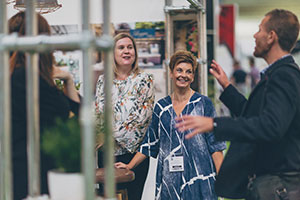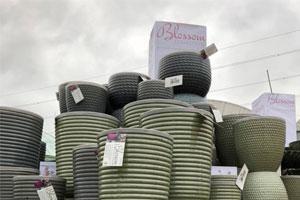What can garden centres learn from supermarkets? Focusing on consumer retail psychology can unlock the secrets to higher sales
Supermarkets roll out a host of sophisticated techniques to encourage shoppers to part with their disposable income. From BOGOF (buy-one-get-one-free) deals to premium products strategically placed at eye level, every aspect of retail space dedicated to fast-moving consumer goods is engineered to maximise spend on high margin products.
The aroma of baking pumped to the front of stores gets customers salivating, ramping-up impulse sales of snacks. Everyday essentials are stacked at the rear of stores, to drive footfall right through the sales area, while checkouts are laden with tempting last-minute treats. Some retailers install smaller floor tiles in areas of higher value goods. It’s said that the sound of trolley wheels rapidly clicking over tiny tiles encourages consumers to slow down – resulting in longer browsing time – and higher spend.
It doesn’t stop there, however. Playing calming or classical music is believed to encourage customers to make big-ticket purchases, while loud music (think Merry Christmas Everybody by Slade, blasting out on Christmas Eve) hurries people through a store. It’s well known that once customers become familiar with a store’s layout, they fail to deviate from their regular path. That’s why retail managers order regular changes of supermarket layout, keeping consumers on-site for longer and picking-up new items as they hunt down regular goods.
The proven strategy of rounding down prices – an essential element of retailing for decades, is as relevant today as it was in an analogue age prior to EPOS. Selling an item at £1.99, for example, still encourages consumers to regard the product as being priced at £1, increasing the odds of a sale being made.
Of course, garden centres are different beasts to supermarkets, but by taking a closer look at retail psychology, and embracing similar merchandising strategies, retailers can increase sales for relatively little investment. We spoke to leading garden centre retail consultant Neville Stein, in a bid to identify how garden retailers can tap into consumer retail psychology and boost sales.
1) Embrace cross-selling
Garden centres have long cottoned on to the concept of linked sales – pots, containers and fertilisers by a display of  bedding plants, for example, or pot covers and houseplant food in the indoor plants section. But when it comes to cross-selling, some retailers need to take a fresh approach to maximise sales potential.
bedding plants, for example, or pot covers and houseplant food in the indoor plants section. But when it comes to cross-selling, some retailers need to take a fresh approach to maximise sales potential.
Neville explains: “An area that garden centres often get wrong is product adjacency and cross-selling. When a customer buys a piece of garden furniture, the linked sale is the parasol and cushions. The cross-sell is a barbecue. In other words, if the customer is interested in outdoor furniture, they are likely to be interested in outdoor living and might buy a barbecue as well. The technique is to make sure that product adjacencies are correct. Display barbecues next to garden furniture, because both categories go together.”
2) Transform the tills
Supermarkets overload customers with temptation at the checkouts, encouraging last minute impulse purchases. It’s a strategy that’s come under fire from health chiefs for encouraging sales of unhealthy snacks, but garden centres could adapt the temptation principle to boost sales of seasonal items.
Neville explains: “When selling bedding and compost, for example, retailers should put liquid feed on the till, then change displays seasonally, offering low-priced impulse items. Go to a garden centre on a busy bank holiday in May and look at the number of trollies that are full of bedding plants and compost but no fertiliser. Multi-purpose compost contains sufficient nutrients to last for just eight weeks, although many customers won’t know that. It would be great customer care for staff to have recommended plant food to those customers.”
He believes that garden retailers are missing a trick by failing to display enough “pick-up items at the tills,” adding: “Weedkiller – people are always going to pick up a bottle. Bird food is a fantastic seasonal product by the tills, as are pot plants in flower, but also special purchase items like gardening gloves. I know garden centres doing a massive trade in bin liners as a pick-up item at the till. It’s about stuff that you need.”
Just 10 minutes of quick training for checkout staff on how to up-sell items by the tills and provide a better customer experience will help to boost impulse buys further, Neville adds.
3) Direct footfall
Understanding retail psychology isn’t just about tempting customers to splash out a few extra quid at the checkouts. Garden centre restaurants are deliberately placed at the back of the store, or in a far corner, to encourage footfall through key sales areas and drive sales of goods such as food, clothing and giftware. Consumers are less likely to make a purchase in crowded spaces, which create an uncomfortable, pressurised shopping environment, which is why good retailers provide spacious aisles.
It’s well known that shoppers instinctively look to the left when browsing an aisle, which is why many high margin products are placed on the left-hand side of a walkway. But if that doesn’t suit the design of a store, how can managers get customers to veer to sales areas on the right? Neville has a solution: “If you want people to go to the right, because that’s how your layout works, make the aisle to the left is slightly narrower than the aisle to the right. People will move through the path of least resistance, so if the aisle to the right is slightly bigger and wider, customers will move that way.”
4) Use in-store theatre to sell
While supermarkets draw customers with the tempting smell of baking, garden centres can use dynamic in-store displays to sell the dream of outdoor living by creating a bit of theatre - from a living wall to a rainwater harvesting system or a veg plot crammed with bountiful produce. Selling ideas that inspire consumers to purchase the ‘ingredients’ to replicate at home can pay dividends, especially with use of bold colours and features. Neville explains: “A lot of people are using pyramid shapes now for merchandising. It’s a popular technique, as consumers’ eyes shop the entire display.”
5) Increase shop floor staff
With pressure mounting to maintain or increase margins, Neville’s final tip is certain to cause controversy. He explains: “The second largest cost to a garden centre is staff wages. Everyone is focused on reducing that cost and fails to regard staff as an investment. My argument is to put more people on the ground. It will put wage costs up – but managers need to understand what that investment can do to sales if staff are trained correctly.
“Supermarket customers rarely need advice, apart from the location of items. But garden centre shoppers often need to ask questions. The best way to sell is to get staff members to engage with customers. If garden centres want to double their sales, put more people on the shop floor and train them in how to gain rapport with customers. Train them how to identify customers’ needs by using question techniques. Train them in the linear approach that a sales conversation should take. Train them to be good closers. Sales will rocket. “You can improve POS, stage great displays and get layouts right, but if managers want to rocket their sales, put more sales staff face-to-face with customers and get them to engage.”
To see the latest and developments in retail merchandising, make sure to visit the Retail Lab at Glee, which takes place at Birmingham’s NEC from 10-12 September. Now in its third year, the lab, in association with the HTA, is bursting with ideas and innovation. Glee Event Director, Matthew Mein, said: “The Retail Lab has firmly established itself as the beating heart of the show; an unrivalled source of inspiration for merchandisers and retail managers who know that staging creative displays will power sales next season. Combined with the latest in product innovation, the Lab will be packed with ideas for retailers of all sizes.”
This year the Retail Lab will focus on two key themes ‘Shop’ and ‘Nature’, both of which will be supported by eight key themes entitled - Do it Yourself, Plant and Gift Shop, Garden Therapy, ‘Do Nothing’, Plastic Free Future?, Urban Green City, Outdoors = Indoors, Nurturing Nature, and Pet Alley – all of which represent key growth opportunities for garden retailers, whilst also addressing those issues that are shaping consumer spending habits.
Once again, the Retail Lab @ Glee – in association with the HTA - will be created in partnership with a panel of industry experts, led by Creative Director, Romeo Sommers of ByRomeo.
In addition to the amazing team behind the Retail Lab, the area will also be supported by a number of sponsors. Woodlodge, Scheurich, Key Essentials, Apta, Meadow View Stone, Verona, Laurica Plants, BPI Products, Ivyline, and Air So Pure are confirmed as 2019 Supplier Partners, providing them a wealth of opportunity to promote their brand and latest product innovations.
Find out more
To keep up-to-date on the latest Glee news visit www.gleebirmingham.com. To enquire about exhibiting at Glee 2019 call +44 (0)203 3545 9752.


 bedding plants, for example, or pot covers and houseplant food in the indoor plants section. But when it comes to cross-selling, some retailers need to take a fresh approach to maximise sales potential.
bedding plants, for example, or pot covers and houseplant food in the indoor plants section. But when it comes to cross-selling, some retailers need to take a fresh approach to maximise sales potential.